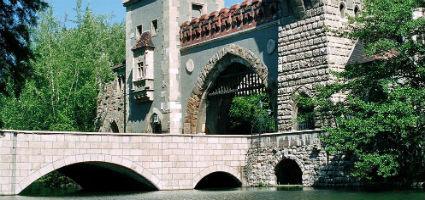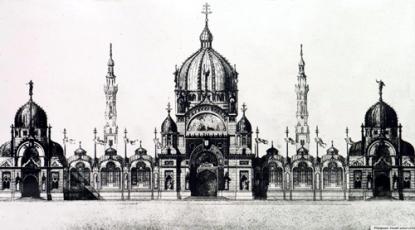2024. May 2. Thursday
Museum and Library of Hungarian Agriculture - Budapest
 |
Address: 1146, Budapest Városliget, Vajdahunyadvár
Phone number: (1) 363-1117
E-mail: info@mmgm.hu
Opening hours: 01.03-31.10.: Tue-Sun 10-17
01.11-28.02.: Tue-Fri 10-16, Sat-Sun 10-17 |
The exhibition has closed for visitors.
2005.03.25. - 2005.10.15.
Museum tickets, service costs:
|
Individual ticket
|
300 HUF
|
|
|
Individual ticket
|
600 HUF
|
|
|
Ticket for adults
|
1600 HUF
|
|
|
Group ticket for adults
|
500 HUF
|
|
|
Ticket for students
|
800 HUF
|
|
|
Ticket for pensioners
|
800 HUF
|
|
|
Individual combined ticket for adults
|
2100 HUF
|
|
|
Individual combined ticket for students
|
1300 HUF
|
|
|
Individual combined ticket for pensioners
|
1300 HUF
|
|
|
Guide for adults
|
5000 HUF
|
/ capita
|
|
Group guide for students
|
3000 HUF
|
|
|
Group guide
|
8000 HUF
|
One of the most significant architect of the heydays of Hungarian architecture, the late historicism at the turn of the century, was born in Józsefváros on 17, January 1855 in a craftsman’s family. His father, Schöckl Mátyás, a joiner in Pest, worked for the biggest constructions in the city. His mother, Eisele Mária, was born as the daughter of an artisan who moved to Hungary from Württenberg. Ignác, who was still called Schöckl at that time, became a mason apprentice after finishing real school. He received his letter signing the end of his apprentice in 1873.

He began to work in Hauszmann Alajos’s office who encouraged him to study architecture. He did so and moved to Berlin where he began his studies at the Academy of Architecture in 1874 in the spirit of the neo-renaissance. After finishing the academy, he worked in an architecture office in Berlin. In 1880, he won the Schinkel Coin. That year he changed his name to the Hungarian Alpár. After returning from his journey from Italy, he was invited by Hauszmann to teach at the University of Arts in Budapest.
In 1881-1888, he taught at the ornamental architecture department. In the meantime, he fulfilled several applications. He married Orth Antonia, the daughter of a tradesman from Arad, in 1883. He won the application to design the spa of-Herkulesfürdői named Szapáry. Following this, he was entrusted with a number of commissions. Several of his church and institution designs are significant.
In 1888, he opened a design studio first situated in 7, Teréz Boulevard. Later he moved to 11 Almássy Square. His well organized office prospered soon.
His biggest success came in the 1890`s with his buildings made for the Millennium exhibitions, one of them was the Vajdahunyadvár that was reconstructed later. In 1900-1914, his most important designs were banks that are still very important parts of the view of Budapest now. However, his buildings can be found all over the country.
On the 70th birthday of the successful architect, his embossed portrait was set on the wall of Vajdahunyadvár. After the death of his wife, he married Csesznák Ilona in 1918. He died on returning home from his journey n America on 27, April 1928 in Switzerland. His body was laid out in the Vajdahunyadvár, and then his body was taken to the Kerepesi cemetery.

He began to work in Hauszmann Alajos’s office who encouraged him to study architecture. He did so and moved to Berlin where he began his studies at the Academy of Architecture in 1874 in the spirit of the neo-renaissance. After finishing the academy, he worked in an architecture office in Berlin. In 1880, he won the Schinkel Coin. That year he changed his name to the Hungarian Alpár. After returning from his journey from Italy, he was invited by Hauszmann to teach at the University of Arts in Budapest.
In 1881-1888, he taught at the ornamental architecture department. In the meantime, he fulfilled several applications. He married Orth Antonia, the daughter of a tradesman from Arad, in 1883. He won the application to design the spa of-Herkulesfürdői named Szapáry. Following this, he was entrusted with a number of commissions. Several of his church and institution designs are significant.
In 1888, he opened a design studio first situated in 7, Teréz Boulevard. Later he moved to 11 Almássy Square. His well organized office prospered soon.
His biggest success came in the 1890`s with his buildings made for the Millennium exhibitions, one of them was the Vajdahunyadvár that was reconstructed later. In 1900-1914, his most important designs were banks that are still very important parts of the view of Budapest now. However, his buildings can be found all over the country.
On the 70th birthday of the successful architect, his embossed portrait was set on the wall of Vajdahunyadvár. After the death of his wife, he married Csesznák Ilona in 1918. He died on returning home from his journey n America on 27, April 1928 in Switzerland. His body was laid out in the Vajdahunyadvár, and then his body was taken to the Kerepesi cemetery.
